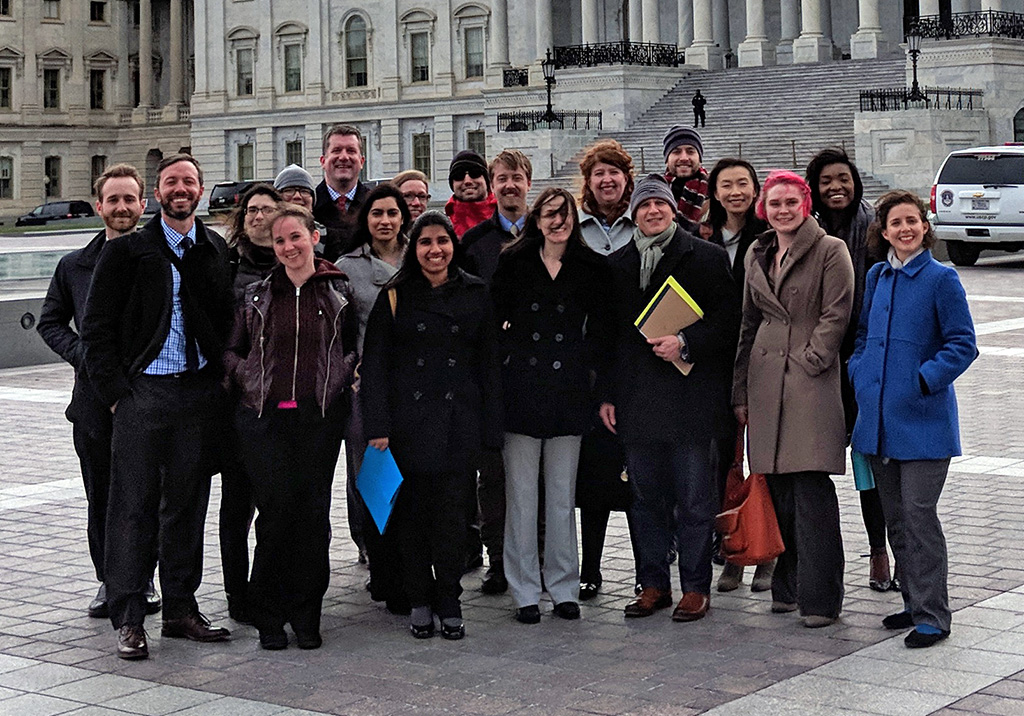AAS Visits Capitol Hill to Advocate for Investment in Astronomy
Ashlee Wilkins
This post is adapted from the AAS press release on the 2018 AAS Congressional Visits Day:
Twenty-one astronomers, solar physicists, and planetary scientists from the American Astronomical Society (AAS) took to Capitol Hill on Wednesday, 14 March 2018, to advocate for robust federal investment in the astronomical sciences as part of by the National Aeronautics and Space Administration (NASA), the National Science Foundation (NSF), and the Department of Energy (DOE) Office of Science. Traveling in teams of volunteers comprising three AAS members led by a policy-experienced astronomer, the group collectively held 41 meetings in offices of senators and representatives from 15 states.
 Left to right: Jacob White, Christopher Richardson, Jessica Rosenberg, Laura Lopez, Laura Penny, Joel Parriott, Monica Bobra, Britt Lundgren, Roohi Dalal, Loren Matilsky, Nathan Miles, Misty Bentz, Ashlee Wilkins, Jeff Bary, Nicholas Gorgone, Wenli Mo, Kendall Hall, Ayanna Jones, and Heather Bloemhard. Not pictured: Bethany Johns, Hua Liu. Photo courtesy Jeff Bary.
Left to right: Jacob White, Christopher Richardson, Jessica Rosenberg, Laura Lopez, Laura Penny, Joel Parriott, Monica Bobra, Britt Lundgren, Roohi Dalal, Loren Matilsky, Nathan Miles, Misty Bentz, Ashlee Wilkins, Jeff Bary, Nicholas Gorgone, Wenli Mo, Kendall Hall, Ayanna Jones, and Heather Bloemhard. Not pictured: Bethany Johns, Hua Liu. Photo courtesy Jeff Bary.
The AAS brings member volunteers to the Hill for its Congressional Visits Day (CVD) program every spring, typically coinciding with the start of Congress’s formulation of spending packages for the coming fiscal year after receiving the president’s budget proposal in February. The AAS Public Policy staff, elected leaders, and Committee on Astronomy and Public Policy (CAPP) jointly develop Congressional “asks” for spending at NASA, NSF, and DOE, often in coordination with coalitions of scientists from other disciplines. Those priorities are woven into the messages CVD participants bring to the Hill, but AAS member volunteers/constituents are also able to bring their own personal stories of the value of federal investment in the astronomical sciences to their home institutions, districts, and states.
“Members of Congress, particularly those already engaged on science issues, value input from AAS staff and leadership as representative of the astronomical science community,” says Ashlee Wilkins, the AAS’s John Bahcall Public Policy Fellow. “But representatives and senators ultimately care most about what their constituents value. Face-to-face meetings between constituents and their members of Congress (or the members’ staff) can be quite powerful, and studies consistently show that such meetings are the most effective advocacy tool.”
Participants brought messages to Capitol Hill on the importance of community-derived priorities provided in decadal surveys and the value of the astronomical sciences as part of a strong national portfolio of discovery research. This year’s CVD volunteers were particularly concerned about the administration’s proposal to diminish NASA’s investment in its astrophysics program by 12%. The cut would force the cancellation of the Wide Field Infrared Survey Telescope (WFIRST), currently in development and the top-priority space mission of the 2010 New Worlds, New Horizons in Astronomy and Astrophysics decadal survey. Many of this year’s volunteers work on research that is either laying the groundwork for WFIRST or depends critically on the data that WFIRST is intended to deliver after its intended mid-2020s launch.
Before visiting Capitol Hill, the volunteers participated in training activities at the AAS Executive Office in downtown Washington, DC. Participants got a whirlwind education on the federal budget process, the roles of agency leaders, the specific opportunities and challenges in the current budget and political landscape, and how to effectively communicate their messages. In providing this training, the AAS aims to prepare CVD volunteers not only for the visits immediately thereafter, but also for maintaining positive relationships with the offices they visit and, more broadly, for being strong advocates for science throughout their careers.
“It is more important now than ever for scientists to engage in public policy,” says Kevin Marvel, AAS Executive Officer. “Our CVD activities do more than just provide a way to advocate for astronomy and related sciences; they provide an immersive learning experience. Most participants continue advocating on their own and encourage others to do so as well,” Marvel continues. “CVD is a high-leverage, high-impact event, and I thank the participants for their time and engagement.”
AAS CVD 2018 Participants:
- Jeff Bary (Colgate University)
- Misty Bentz (Georgia State University)
- Heather Bloemhard (American Association for the Advancement of Science)
- Monica Bobra (Stanford University)
- Roohi Dalal (Caltech)
- Nicholas Gorgone (George Washington University)
- Kendall Hall (University of Wisconsin, Madison)
- Bethany Johns (American Institute of Physics)
- Ayanna Jones (Georgia Tech)
- Hua Liu (American Astronomical Society)
- Laura Lopez (Ohio State University)
- Britt Lundgren (University of North Carolina, Asheville)
- Loren Matilsky (University of Colorado, Boulder)
- Nathan Miles (Space Telescope Science Institute)
- Wenli Mo (University of Florida)
- Joel Parriott (American Astronomical Society)
- Laura Penny (College of Charleston)
- Christopher Richardson (Elon University)
- Jessica Rosenberg (George Mason University)
- Jacob White (University of British Columbia)
- Ashlee Wilkins (American Astronomical Society)

